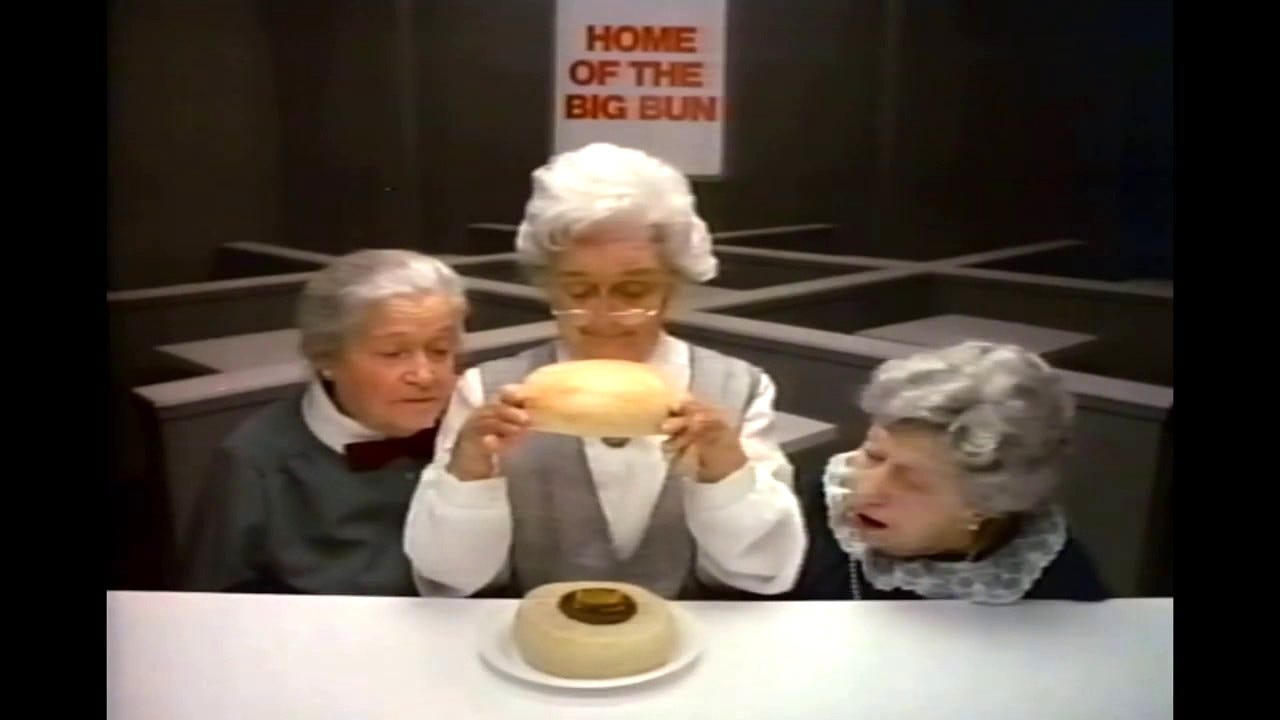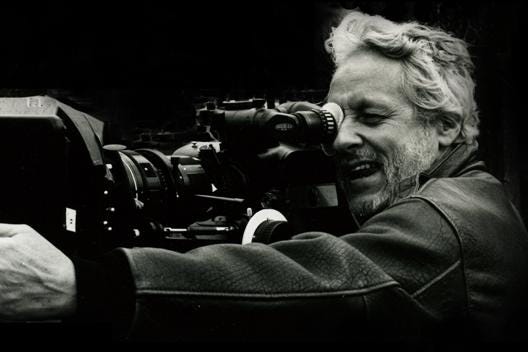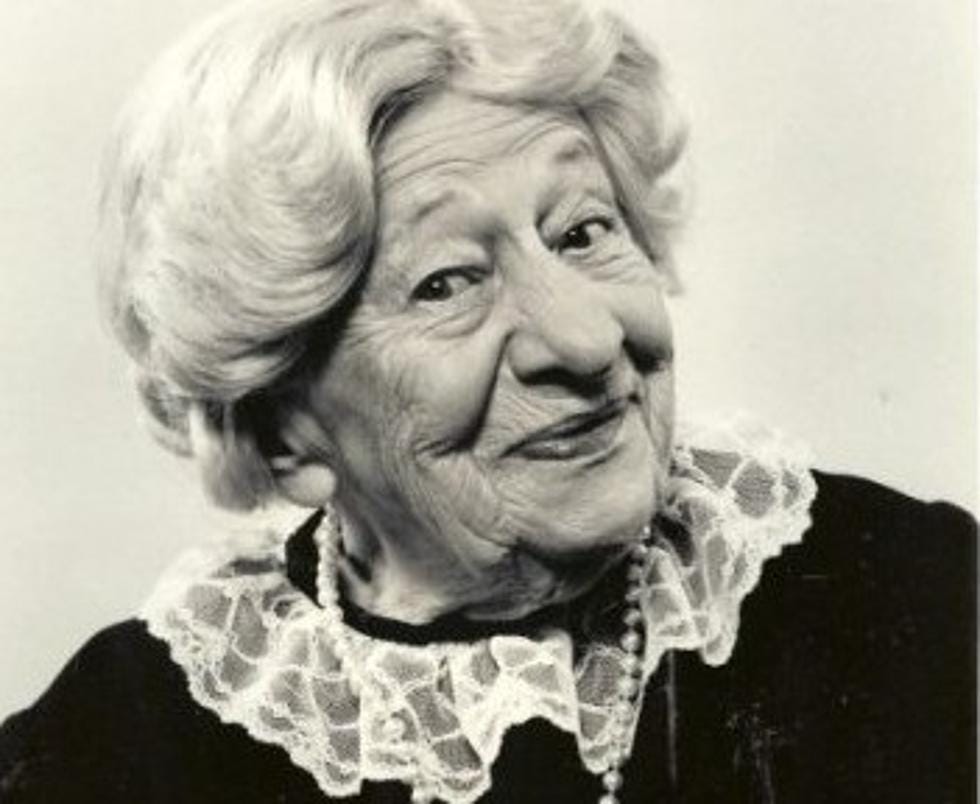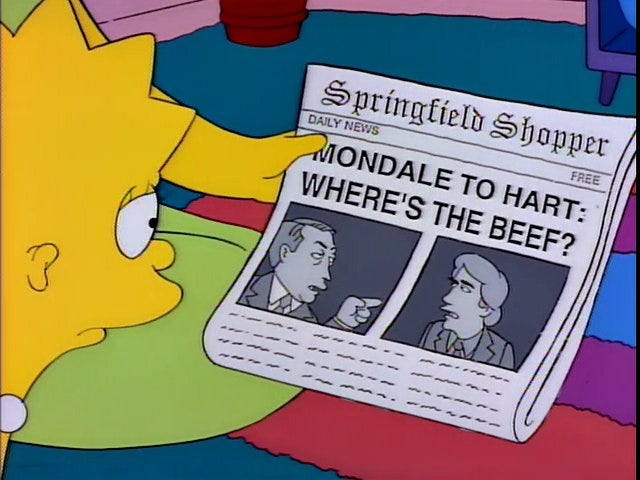Where's the Beef Wendy's Man Voice Text
"Where's the Beef?" The Story of the Most Famous Slogan Ever
How i line changed pop culture and even an ballot

When you think of famous commercial slogans, which ones come to mind? There are probably a few specific ones burned into your memory. Many iconic commercials and catchphrases take existed over the years, but in the 1980s one rose in a higher place them all.
"Where's the Beefiness" was a commercial catchphrase for Wendy's that came out in 1984 and was used to question other fast food companies for their lack of meat. It starred unknown actress Clara Peller and was created by the groundbreaking Joe Sedelmaier. The phrase skyrocketed Wendy's profits and became one of the most famous catchphrases of all fourth dimension.
Setting the Stage for "Where's the Beef"
At that place have been many iconic catchphrases from commercials over the years. Some that may come to mind include:
- I'g Lovin' Information technology
- Finger-Lickin' Expert
- They're G-R-R-R-reat!
- Just Do Information technology
- A Diamond Is Forever
- Whassup (detest it or not, that thing didn't go anywhere…)
But in the 1980s, one catchphrase ruled them all — "Where's the Beef?" If you grew up during this time, you know how iconic this catchphrase was. It had a tremendous impact on pop civilisation throughout the decade and beyond. Information technology would exist repeated everywhere and made Clara Peller — the woman who uttered the phrase — world famous.
The phrase "Where'southward the Beef" continued to grow and would be used to question things such as ideas, events, or products as to if they had whatsoever substance. The story of "Where's the Beef" is nigh how catchphrases tin spread like wildfire, an unlikely glory, and an advertising director who changed the way we make commercials.
Why Was the "Where'south the Beefiness" Commercial Needed?
McDonald'due south and Burger Rex were leaders of the fast-food burger market, and they promoted the size of their burgers with products similar the "Big Mac" and the "Whopper."
Wendy's didn't have any specific "big-proper noun" type burger, and most of their products were unmarried patty burgers. Only they independent more meat than they believed people realized.
They wanted to showcase that their hamburger had more beef and that McDonald's and Burger King were hiding their lack of meat by using larger buns. Wendy's wanted to call them out for these tactics while showcasing that they had more beefiness. Then how would they do this?
Bring In Joe Sedelmaier

Sedelmaier was an art manager at Young & Rubicam and J. Walter Thompson, which if y'all know your Mad Men, are big-time ad companies. Commercials used to e'er feature glamorous looking people and models as they tried to create an idealistic impression of people to sell their products.
These days, though, we get a good mix of that and more comedic based advertising — every bit y'all see in a lot of Super Bowl spots. Today, y'all're but equally probable to run across a regular-looking person in an ad as you are a Kardashian.
This seems normal but wasn't the case in the '70s and '80s. During this fourth dimension period, commercials would use flawless-looking people to create an image of perfection for whatever product was being sold.
Sedelmaier changed all of this and contradistinct the appearance of how commercials looked. Instead of using perfect looking actors, he cast regular-looking and sometimes not bonny people.
Again, this doesn't seem like a big deal today, but this was groundbreaking in the '70s and into the '80s. He also gave commercials a looser experience instead of making them await similar a glossy, movie-like production. He wanted to brand commercials more fun and engaging, as opposed to looking similar every other advertisement you've ever seen.
His commercials would include things like people making strange expressions, sped upwardly and slowed down movements, and exaggerated loping walks. Sedelmaier said that "a commercial is something yous watch when you sit downwardly to lookout man something else — you should at least be entertained."
It was this approach that fabricated him a rock star in the advertising world. He would win multiple Clio awards and was a highly sought later on talent. Sedelmaier was the man behind the FedEx "fast-talking man" commercials, and he was just what Wendy's would demand to deliver their message.
Creating "Where's The Beef" & the Different Variations

The project was put in place past Wendy'southward international vice president, William Welter, who led the marketing team going into the campaign. Assisting Welter was Dan Dahlen, a 35-year advert veteran who worked for the Wendy's ad team from 1982 to 1986.
Their goal was to show other places using buns to hide their meat and use regular people in the ad in the mode Sedelmaier had fabricated and so effective. Information technology started out as a commercial featuring a young couple; they were regular looking people — not models per se — but the ad simply wasn't funny.
For the next versions of the advertisement, they came up with a storyboard for two different versions of the commercial afterwards they ditched the young couple.
One version featured a trio of older men with one of them, an elderly bald human, maxim, "Thanks, but where's the beef?" It didn't seem to connect very well, merely they had another version they had filmed with three older ladies, including i named Clara Peller that they had discovered.
Peller was born in 1902 and had spent 35 years working for a dazzler salon in Chicago. A commercial being filmed in Chicago needed to be set in a barbershop and required a manicurist. They took a chance on casting the eighty-year-sometime Pellar to play the part.
The agency filming the commercial loved her no-nonsense manner and unique vocalisation. They believed they could brand use of her and signed her to an agency contract. Peller was hard of hearing and could only recite brusque lines of dialogue so that limited what she could practise on camera.
She started appearing in several commercials and defenseless the eye of the people from Wendy's who cast her in their new commercial. She would be instrumental in the commercial's success.
Getting the Commercial on the Air
With the two versions of the commercial now set, they took it to the ad committee, made up of six executives and 10 franchisees. They rejected information technology. The commission thought the version with Peller was a petty likewise sharp considering of her louder and harsher way of speaking.
They reworked some things, and the second version of the commercial — the one yous know — got the thumbs up. Many probably don't remember this, but the version with the trio of men actually aired alongside the version with Pellar in an former-fashioned a/b carve up testing.
The version with Peller snowballed, making them dump the 1 with the old men and focus on the trio of older ladies. The commercial defenseless on similar wildfire. Even though it was supposed to run for just a short while, the explosion in popularity kept it on the air for ten weeks.
The Massive Impact of "Where's the Beef"
Advertising is tough today. There are then many things vying for your attending, making it hard for advertisers to discover the correct platform. In the '80s, with just three networks, it was much easier to get your message beyond to a vast majority of the viewing public.
At that place was and so fiddling else vying for people's attending that anything on network tv set could blow upwards by the side by side day. Entire careers could be made past 1 proficient musical performance or stand-up comedy set. You could be an unknown comic, take a great attack Johnny Carson, and the next day you were a household proper noun.
This was the case with the "Where'due south the Beefiness" commercial when it aired in 1984. Everyone was immediately aware of information technology and embraced its uniqueness. It caught on so fast that it became a cultural phenomenon and made Peller somewhat of a cult star.
This paid off large time for Wendy'due south as every Wendy'south eating place generated at least 10% more sales in 1984 than they did in 1983. Overall sales jumped by 31% to $945 1000000 worldwide past 1985.
The Cultural Touch on of "Where'south the Beef"

"Where'southward the Beef" fabricated the rounds on late-night talk shows and even turned into a song. A Nashville songwriter named Coyote McCloud recorded and performed his version of "Where's the Beef," and information technology was a pretty big hit.
"Where'southward the Beefiness" then crept its way into the 1984 presidential election.
During the primaries of the spring of 1984, Democratic candidate and former vice-president Walter Mondale used the phrase against opponent Gary Hart. Mondale stated that the plan policies put frontward by Hart were lacking in substance. This was at the top of the popularity of the commercial and was a keen style to tap into the public consciousness by using a topical phrase that was also a cutting jab.
This all happened during a televised argue just earlier the New York and Pennsylvania primaries. Hart was seen as being in a similar mold to John F. Kennedy — especially in appearance. His platform was based on the concept of "new ideas."
Hart had gone from a night horse to more than of a threat and kept pushing the "new ideas" viewpoint in all his debates. Mondale seemed like he was waiting for this and after Hart repeated it during the debate, Mondale leaned over and says:
"When I heard your new ideas, I'grand reminded of that advertisement, 'Where'southward the beef?'"
Hart would eventually accept to physically show his policy papers and tell Mondale, "Here'southward the beef." Mondale kept pushing virtually "where'southward the beef" with Hart'due south policies and the public started seeing them the aforementioned fashion. It ended upwards casting uncertainty on Hart's new ideas and helped Mondale win the Democratic nomination.
The Legacy of "Where'southward the Beef"
Following all of this, Wendy's would enter a big two-year sales slump. This was probably because catchphrases come and go quickly, and the success is more oft virtually the catchphrase than the brand itself.
Wendy's said it would have five years until they recovered and could create brand sensation once more. But they cemented their place in history with one of the most popular slogans always. Advertizement Historic period named it one of the peak x advertisement slogans of the 21st century and it helped propel Wendy's into the third-largest burger chain in the earth.
What started out as an attempt past Wendy's to phone call out their competitors turned into a pop-civilization milestone.
Source: https://bettermarketing.pub/wheres-the-beef-the-story-of-the-most-famous-slogan-ever-550d3f0c48c
Postar um comentário for "Where's the Beef Wendy's Man Voice Text"